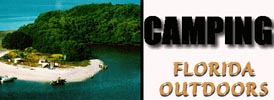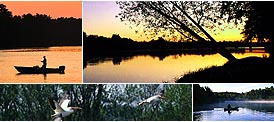


Backcountry
Campsite Map
Everglades National Park has three kinds of backcountry campsites:
Chickees
Chickees are located along interior rivers and bays where no dry land exists.They
are elevated 10' x 12' (3 m x 3.7 m) wooden platforms with roofs,
usually constructed on open water, well away from mangrove trees. A narrow
walkway leads to a self-contained toilet. You'll need a free-standing tent,
since stakes or nails are not allowed.
Miccosukee Indians describe a chickee as an open-air structure which allows wind to blow through for comfort on hot days and to keep insects away. Everglades backcountry chickees serve a similar purpose.
Ground Sites
Ground sites are mounds of earth a few feet higher than the surrounding
mangroves, located along interior bays and rivers. They tend to have more
insects than chickees or beach sites.
Some ground sites are old Indian mounds. Coastal aboriginals, who lived here well before the Seminoles, constructed mounds of shell or soil as dry dwelling sites amidst the mangroves. Others, such as the Lopez River campsite and the Watson Place, were cleared by early settlers.
Beach Sites
Beach sites are located on coastal shell beaches. During ideal conditions,
insects may be scarce, but always be prepared for mosquitoes and no-see-ums
(tiny biting flies), especially at sunrise and sunset. People in small craft
should be aware that Gulf waters at beach sites can become extremely rough;
seas can exceed 3 feet (1 m).
Sand beaches are often stabilized by tall, grassy plants called sea oats. Take care not to damage them. Sea turtles nest on beaches in late spring and summer. Avoid camping or building a fire where sea turtle nesting evidence exists. Many beach sites have no toilets. Bury human waste at least six inches (15 cm) below the surface or, preferably, pack it and toilet paper to the nearest toilet.
Most of south Florida's natural beach is built up from the shells of multitudes of marine organisms. While some shells are fragmented, many can be discovered completely intact. Some beaches, such as Highland Beach and Cape Sable, serve as essential nesting sites for the loggerhead sea turtle (Caretta caretta).












